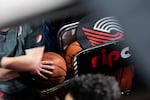Aside from the Nike swoosh, the Portland Trail Blazers might have the most easily recognized logo in the state of Oregon. It’s plastered on sweatshirts, license plates and across the Moda Center.
It’s one of the most unusual logos in professional sports. And it’s not going anywhere.

A member of the Trail Blazers promotion team prepares to wheel out a cart of basketballs during a National Basketball Association game between the Portland Trail Blazers and the Toronto Raptors at the Moda Center in Portland, Ore., Wednesday, Nov. 13, 2019. The Raptors won 114-106.
Bradley W. Parks / OPB
Fifty years ago, sports promoter Harry Glickman decided to bring professional basketball to Portland.
This meant he needed a coach and a team name. He needed players. And he needed a logo.
So he tapped his cousin, Frank Glickman, a graphic designer in Boston.
During that time, Frank recalls, “pure geometry” was the hot trend when it came to logo design. So, a few weeks after his cousin first called him, Frank sent Harry a sketch: five curved black lines hooked over five red ones.
Related: 'Give Me The Damn Letter': How Portland Got The Trail Blazers
Those lines, Frank told Harry, represented five on five, offense and defense. The hole in the middle was a basketball.
Fast forward 50 years, and this logo has cemented its status as the most unusual amongst the 30 NBA teams.
The other 29 can be siphoned into four categories: Some feature the team’s mascot: The Chicago Bulls logo is, well, a bull. Those featuring a basketball — think, the Los Angeles Lakers. Those depicting a part of the city, like the Oakland Bay Bridge for the Golden State Warriors. Or something in the team name itself: a spur for the San Antonio Spurs; a rocket for the Houston Rockets.
Not the Blazers.
Some fans love this.
When OPB recently visited the Moda Center, fans maintained again and again they had “the best logo in all of sports.”
Others are less enthusiastic.
It's been called too corporate. Too abstract. Too much like it belongs on the awning of a bank. Design experts have decried it as "so 1970s," with "no personality."
A few years ago, the Blazers were mulling a logo update, even considered starting from scratch. They invited fans to participate in a focus group to hear what they wanted to see in a new logo.
Mario Milosevic, the Blazers art director, said none of the attendees were ready to scrap the pinwheel.
“They just wanted us to keep what we had and, so that's what we did,” Milosevic said. “We kept kind of the historical elements but polished it a little to just to be a little bit more with the current time.”
Rodney Richardson owns a design firm in Mississippi that has helped every team from the Washington Wizards to the Los Angeles Lakers with rebranding. He was tapped by the Blazers back then to help with the potential redesign.
He said Frank’s logo, slightly space-agey, would never get approved today.
“Look, if you design this right now, and this was a brand new design, would it be accepted? Could you get it through?” he said. “And because it's abstract in nature, because of the story that it's telling, or even not telling, I don't know that you could.”
But, he said, it’s also not surprising that no one wants it changed. This is how logos – or as he calls them, “marks” – work.
“People feel a passionate connection to their teams,” he said. “They feel that they have ownership of these marks or they are, you know, this vested interest in them personally. And they're passionate about that.”
In the NBA of today, nothing is forever. Players can be traded. They can leave during free agency. They can retire.
But, for now at least, 50 years after Frank Glickman designed it, the Blazers logo is here to stay.
Correction: An earlier version of this story incorrectly noted which bridge features in the logo of the Golden State Warriors. OPB regrets the error.
